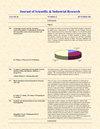基于NDWI、MNDWI和侵蚀模型的印度Ropar湿地变化及土地利用活动影响分析
IF 0.8
4区 工程技术
Q3 ENGINEERING, MULTIDISCIPLINARY
引用次数: 0
摘要
罗帕湿地是位于印度旁遮普的重要淡水生态系统。近年来,由于人为和自然因素的影响,该湿地发生了明显的变化。本研究利用Landsat影像和GIS软件,利用遥感技术对罗帕湿地周边土地利用和土地覆被变化进行分析。结果表明,农业用地比例从2000年的19%上升到2010年的37%,随后下降到2020年的28%。荒地、城市和休耕地也从2000年的20%持续增加到2020年的44%。森林覆盖率从2000年的47%下降到2020年的17%,水体从2000年的14%下降到2010年和2020年的10%。土地利用土地变化(LULC)多年来的变化,包括罗帕尔湿地的面积,提供了对土地利用和覆盖变化模式的深入了解。NDWI(归一化差水指数)结果显示,多年来湿地水体面积减少幅度较小,总面积有一定波动。MNDWI (Modified Normalized Difference Water Index)表示湿地周围的稀疏水域面积。在过去的二十年里,包括侵蚀和增生在内的自然过程影响了河流周围的湿地区域,造成了55公顷土地的净损失。本研究的结果表明,有必要实施有效的管理措施,认识到土地利用、水文和生态过程之间复杂的相互关系,以保护罗帕湿地的生态和水文功能。持续监测和评估土地利用和覆盖变化对保护湿地生态系统至关重要。本文章由计算机程序翻译,如有差异,请以英文原文为准。
Integrating NDWI, MNDWI, and Erosion Modeling to Analyze Wetland Changes and Impacts of Land Use Activities in Ropar Wetland, India
The Ropar Wetland is a significant freshwater ecosystem located in Punjab, India. In the recent years, this wetland has witnessed significant changes owing to anthropogenic and natural factors. In this study, the land use and land cover changes are analyzed around the Ropar Wetland using remote sensing techniques by utilizing Landsat images and GIS software. The results showed a significant increase in agricultural land from 19% in 2000 to 37% in 2010, followed by a decrease to 28% in 2020. Barren, urban, and fallow land also showed a continuous increase from 20% in 2000 to 44% in 2020. The forest cover decreased from 47% in 2000 to 17% in 2020 and water bodies decreased slightly from 14% in 2000 to 10% in both 2010 and 2020. The pictorial representation of LULC (Land Use Land Change) changes over the years, including the area of the Ropar Wetland, provided insight into the shifting patterns of land use and cover. Results from NDWI (Normalized Difference Water Index) show a small decrease in water body area in the wetland over the years, with some fluctuations in the total area. MNDWI (Modified Normalized Difference Water Index) shows the sparse water area around the wetland. Natural processes including erosion and accretion have affected the wetland region around the river, causing a net loss of 55 hectares of land, over the past two decades. The findings of this study suggest that there is a need to implement effective management practices that recognize the complex interrelationships between land use, hydrology, and ecological processes to protect the Ropar Wetland's ecological and hydrological functions. Ongoing monitoring and assessing land use and cover changes are crucial for conserving wetland ecosystems.
求助全文
通过发布文献求助,成功后即可免费获取论文全文。
去求助
来源期刊

Journal of Scientific & Industrial Research
工程技术-工程:综合
CiteScore
1.70
自引率
16.70%
发文量
99
审稿时长
4-8 weeks
期刊介绍:
This oldest journal of NISCAIR (started in 1942) carries comprehensive reviews in different fields of science & technology (S&T), including industry, original articles, short communications and case studies, on various facets of industrial development, industrial research, technology management, technology forecasting, instrumentation and analytical techniques, specially of direct relevance to industrial entrepreneurs, debates on key industrial issues, editorials/technical commentaries, reports on S&T conferences, extensive book reviews and various industry related announcements.It covers all facets of industrial development.
 求助内容:
求助内容: 应助结果提醒方式:
应助结果提醒方式:


